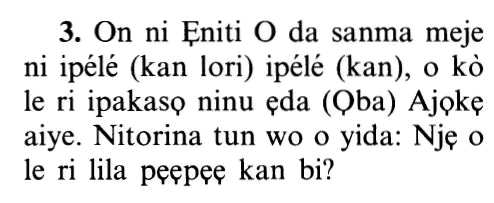67vs3
Select any filter and click on Go! to see results
الَّذِي خَلَقَ سَبْعَ سَمَاوَاتٍ طِبَاقاً مَّا تَرَى فِي خَلْقِ الرَّحْمَنِ مِن تَفَاوُتٍ فَارْجِعِ الْبَصَرَ هَلْ تَرَى مِن فُطُورٍ
Allathee khalaqa sabAAa samawatin tibaqan ma tara fee khalqi alrrahmani min tafawutin fairjiAAi albasara hal tara min futoorin
Yoruba Translation

Hausa Translation
Shi ne wanda Ya halitta sammai bakawi, ɗabaƙõƙi a kan jũna, bã za ka ga goggociya ba a cikin halittar (Allah) Mai rahama. Ka sãke dũbawa, ko za ka ga wata ɓaraka?
Asbabu n-Nuzuul (Occasions of Revelation)
Then Allah says,
الَّذِي خَلَقَ سَبْعَ سَمَاوَاتٍ طِبَاقًا ...
Who has created the seven heavens one above the other;
meaning stacked one on top of the other.
Are they connected to each other, meaning that they are in elevated ascension,
- some of them being stacked above others,
- or separated with space between them
There are two views concerning this, and the most correct opinion seems to be the latter as is proven in the Hadith of Isra' (the Prophet's Night Journey) and other narrations.
Concerning Allah's statement,
... مَّا تَرَى فِي خَلْقِ الرَّحْمَنِ مِن تَفَاوُتٍ ...
you can see no fault in the creation of the Most Gracious.
means, it (the creation) is done in a flawless manner, and these are connected with each other so as to forms a straight level, having no disunion, conflict, inconsistency, deficiency, flaw or defect.
This is the reason that Allah says,
... فَارْجِعِ الْبَصَرَ هَلْ تَرَى مِن فُطُورٍ ﴿٣﴾
Then look again. Can you see any rifts.
meaning, look at the sky and pay close attention to it. Do you see any flaw, deficiency, defect or rifts in it?
Ibn `Abbas, Mujahid, Ad-Dahhak, Ath-Thawri and others said,
"it means cracks".
As-Suddi said that, هَلْ تَرَى مِن فُطُورٍ (Can you see any rifts) means any tears.
Qatadah said, هَلْ تَرَى مِن فُطُورٍ (Can you see any rifts) means,
`do you see any defects O Son of Adam (mankind)'
ثم قال تعالى " الذي خلق سبع سماوات طباقا " أي طبقة بعد طبقة وهل هن متواصلات بمعنى أنهن علويات بعضهم على بعض أو متفاصلات بينهن خلاء ؟ فيه قولان أصحهما الثاني كما دل ذلك حديث الإسراء وغيره وقوله تعالى " ما ترى في خلق الرحمن من تفاوت " أي بل هو مصطحب مستو ليس فيه اختلاف ولا تنافر ولا مخافة ولا نقص ولا عيب ولا خلل ولهذا قال تعالى " فارجع البصر هل ترى من فطور " أي انظر إلى السماء هل ترى فيها عيبا أو نقصا أو خللا أو فطورا قال ابن عباس ومجاهد والضحاك والثوري وغيرهم في قوله تعالى " فارجع البصر هل ترى من فطور " أي شقوق وعن السدي " هل ترى من فطور " أي من خروق وقال ابن عباس في رواية " من فطور" أي من وهاء وقال قتادة " هل ترى من فطور " أي هل ترى خللا يا ابن آدم ؟ .
"الذي خلق سبع سماوات طباقا" بعضها فوق بعض من غير مماسة "ما ترى في خلق الرحمان" لهن أو لغيرهن "من تفاوت" تباين وعدم تناسب "فارجع البصر" أعده إلى السماء "هل ترى" فيها "من فطور" صدوع وشقوق
أي بعضها فوق بعض . والملتزق منها أطرافها ; كذا روي عن ابن عباس . و " طباقا " نعت ل " سبع " فهو وصف بالمصدر . وقيل : مصدر بمعنى المطابقة ; أي خلق سبع سموات وطبقها تطبيقا أو مطابقة . أو على طوبقت طباقا . وقال سيبويه : نصب " طباقا " لأنه مفعول ثان . قلت : فيكون " خلق " بمعنى جعل وصير . وطباق جمع طبق ; مثل جمل وجمال . وقيل : جمع طبقة . وقال أبان بن تغلب : سمعت بعض الأعراب يذم رجلا فقال : شره طباق , وخيره غير باق . ويجوز في غير القرآن سبع سموات طباق ; بالخفض على النعت لسموات . ونظيره " وسبع سنبلات خضر " [ يوسف : 46 ] .
I'raab - grammatical analysis of the Qur'an
«الَّذِي» بدل ثان من اسم الموصول «خَلَقَ» ماض فاعله مستتر «سَبْعَ سَماواتٍ» مفعول به مضاف إلى سموات والجملة صلة «طِباقاً» صفة سبع «ما تَرى » ما نافية ومضارع فاعله مستتر «فِي خَلْقِ» متعلقان بالفعل «الرَّحْمنِ» مضاف إليه «مِنْ تَفاوُتٍ» مجرور لفظا بمن الزائدة منصوب محلا مفعول ترى والجملة استئنافية لا محل لها «فَارْجِعِ» الفاء الفصيحة وأمر فاعله مستتر «الْبَصَرَ» مفعول به والجملة جواب شرط مقدر لا محل لها «هَلْ تَرى » هل حرف استفهام ومضارع فاعله مستتر «مِنْ فُطُورٍ» فطور مجرور لفظا بمن الزائدة منصوب محلا مفعول ترى والجملة في محل نصب بفعل محذوف.
